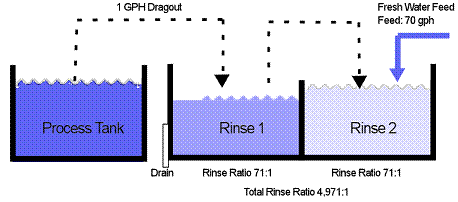10 Minutes to Better Rinsing
Take 10 minutes and learn how to improve rinsing while reducing  water consumption as much as 90%…
water consumption as much as 90%…
In the beginning, the answer to good rinsing was to simply “open the valve all the way”. However, with water/energy conservation and pollution control becoming more and more desirable, not to mention required, finishers are learning to turn off the faucet, save water and recover chemicals whenever possible. And good rinsing techniques not only save water, they help produce quality parts. Submerging work in a tank of running water is how most platers and others in the finishing industry rinse parts. This dilutes the finishing solution clinging to the work by a ratio of dragout plus water flow divided by drag out. Rinse ratio = {D.O. + Water}/D.O.
Example No. 1: Plated work drags 1 gallon of processing solution per hr into a single rinse tank that uses 99 gallons per hour of fresh water. The dilution of the dragout is 100:1. The solution in the rinse tank will be 100 times more dilute than in the process tank.
Mixing or agitating the rinse water ensures the highest dilution ratio. Work can be moved up and down, or air agitation can be used. In barrel plating or processing, it is particularly important to “double-dip” the barrel in the rinse tank, allowing a short drain time over the tank. This exchanges the rinse water in the barrel, providing increased dilution in each rinse tank.
In example No.1, 99 gallons per hour of water is a rather large flow rate, and a 100:1 rinse ratio is not good rinsing. A good rinse ratio for plating work is generally 5,000:1 or even 20,000:1 after chromium plating. But nobody wants to run 5,000 or 20,000 gallons per hour of water through a single rinse.
When two rinse tanks are connected, such that water flows from rinse number two, to rinse number one (figure 1) some beneficial math results. The dragout from rinse number one to rinse number two is re-diluted so that the total dilution is almost the multiplication of the dilution in each rinse tank.
(Figure 1)

Example No. 2: (See Figure 1) 70 gallons per hour counter flow from rinse number two to rinse number one. The one gallon per hour drag out is diluted 71:1 in each rinse tank:
71 x 71 = 5,041:1. (The exact answer is 4,971:1 as a small amount of dilution is lost because slightly contaminated water flows from rinse number two to rinse number one.)
Example No. 3: With three counter flow rinses using only 17 gallons per hour of water, 1 gallon per hour of drag out is diluted by almost 18:1 in each rinse. 18 x 18 x 18 = 5,832:1. (The actual ratio is 5,220:1)
With three rinses, you use less than 1/5 the water used in example N0. 1 and rinsing is 52 times better. You can also say that each additional rinse tank improves rinsing by at least 17 times in this case.
Without having to do any math, Table 1 shows the water requirements using one rinse or as many as five counterflowing rinses. The table provides for several dilution ratios from 100:1 to 20,000:1.
Notice the dramatic change in the water flow required when changing from one rinse to two or more counterflowing rinses. The greatest change takes place when adding the second rinse tank.
Looking across the 100:1 ratio line, there is a 10 time change in flow requirements from one rinse to two rinses. For a higher ratio, for example 10,000:1 the change is even greater. The flow required is one percent (100 gallons) then when using two rinses.
Another interesting aspect of this table is a small change in flow requirements in the five-counterflow column. When using 5 rinses, you need to increase from 2.3 gallons to 7 gallons to change the rinse ratio from 100:1 to 20,000:1. With four or five rinses, a very small change in water flow leverages a large change in rinse ratio.
TABLE 1 – WATER REQUIRED TO DILUTE ONE GALLON OF DRAGOUT |
|||||
Dilution Ratio |
One Rinse |
Counterflowing Rinses |
|||
| (gal) | 2 | 3 | 4 | 5 | |
| 100:1 | 99 | 10.0 | 4.3 | 3.0 | 2.3 |
| 1,000:1 | 999 | 31.0 | 10.0 | 5.4 | 3.8 |
| 5,000:1 | 4,999 | 70.0 | 17.0 | 8.2 | 5.3 |
| 10,000:1 | 9,999 | 100.0 | 21.0 | 10.0 | 6.1 |
| 20,000:1 | 19,999 | 141.0 | 27.0 | 12.0 | 7.0 |
Most existing process lines suffer from a lack of rinsing. Whenever use of adding counterflow rinse tanks is suggested, the most common complaint is that there is no room; thus rinsing suffers and water flow remains high.
When there is a lack of space for extra rinses, there may be other ways of using the rinse water stream more efficiently.
- To gain more immersion rinse tanks you may be able to partition large rinse tanks into two or more smaller sections.
- Counterflowing rinse tanks do not need to be next to each other. An unused tank in another part of the processing line can be used to increase rinsing efficiency.
- Proper racking techniques insure quick run off and reduce the amount of dragout from the process tank.
- When possible, dwell over the process tank to allow the work to drain more completely.
- Using a fog spray while work dwells over the process tank dilutes drag out. A well-designed fog spray can decrease the concentration by 90 percent, while recovering 90 percent of dragout. Use small amounts of freshwater in each fog spray. Using contaminated water from the first rinse tank for spraying may overspray the work and land on the floor, rack hooks and bus bars. Naturally the total spray volume must be limited to the amount that will be evaporated from the process tank.
- Another way to improve rinsing and save water is to add a spray rinse above the last immersion rinse tank. A freshwater spray in this location can provide all the water for the counterflowing tanks and it rinses the work with fresh uncontaminated water.
The Drag Out Tank (Dead Rinse): Much has been said, and still more is believed, about drag out tanks. Two things are true about drag out tanks. First, if there is no water inlet or outlet, the tank is truly dead and useless. The concentration will increase to where it is the same as the process tank (If the concentration is the same as the process tank, there will be no benefit in submerging the part, and if the concentration increases beyond the concentration of the process tank, submerging the part will be detrimental to the goal of rinsing). Second, if some water does leave the dragout tank (to the process tank or drain) and then make-up water must be piped in, this defines a rinse tank.
You will use less water and get better rinsing if the dragout tank is used as the rinse and is included in the chain of counterflowing rinses.
Sprays: Spray rinsing can be compared to a series of counterflowing rinses. The dilution ratio of the fresh water spray increases with the length of time the water impinges on the work. Therefore, a fresh water spray can be an efficient rinse if all the spray water hits the work.
Almost all work can be spray rinsed. Some work presents a greater challenge than others. Racked work should be positioned so that none of the parts “shadow” those behind them. The secret is to concentrate on effectively reaching all work surfaces with the smallest amount of water, rather than flooding the work with high flow rates in the hope of doing an adequate job.
Work that is processed in rotating barrels can be spray rinsed in two ways. After any of the processing cycles, barrels can be stopped, opened and manually sprayed. Or, at the end of the processing cycle, barrel contents can be spilled into a tray and sprayed with fresh water. The tray can be the loading chute for a spin dryer or the spin dryer basket itself. This water is then collected and sent to the last counterflowing rinse station.
Regardless of the load configuration; process barrels, tubular furniture, hollow doorknobs or work containing blind holes, all can benefit from a final fresh water spray over the last immersion rinse. The sprayed water may not reach the inside of the work but it will go a long way in cleaning the outside and reducing carryover to the next process. Spraying the outside of the rotating process barrel with a flat, fan spray not only cleans the outside but removes most of the contaminated water from the barrel’s perforations.
Counterflowing Sprays: There are situations where it is impractical or impossible to increase the number of counterflowing rinses. It may be too expensive to expand the automated process line to add counterflowing rinse stations. If, however, the type of work process can be spray rinsed, then one rinse tank can be dedicated to counter flow sprays.
The technique can produce all the advantages of counterflowing immersion rinses while using only one rinse tank. A piece of off-line equipment delivers counterflow water to the rinse tank in the form of separate, progressively cleaner sprays. The equipment then collects the used spray water and returns it to the proper compartment in the spray equipment.
The Bottom Line: Any method used for dragout recovery or waste water minimization is made more practical and economical when water flow is reduced. It is always easier and cheaper to get one pound of materials from one gallon of water than to get one pound from 100 gallons. If you use counterflow rinsing (with or without sprays), you will get better rinsing, save an abundance of water and increase profits.
Reprised from an article originally appearing in Products Finishing Magazine
Products Finishing Magazine surveyed a representative sample of readers, asking about plating solution dragout and dragout recovery.
The survey showed that a lot of platers need a refresher course in the mathematics of counterflow rinsing (see accompanying article).
A total of 250 readers answer our survey (we greatly appreciate your taking time to do that).
Here are the results:
Water Saved by Counterflowing
We asked readers to circle the amount of water they estimate would be saved by using three counterflow rinses rather than a single rinse. The choices were 25%, 50%, 75%, 95%, and 99%. Survey results (number of persons making each choice):
25% 31
50% 63
75% 47
90% 38
99% 7
As the accompanying article explains, the correct answer is partially determined by the dilution ratio required. If a plater requires the generally accepted dilution ratio of 5000:1, for example, he'd need 4,999 gallons to rinse away one gallon of dragout, if only one rinse were available, but only 17 gallons if he had used a three tank counterflow. Thus he would have saved 4,999-17 = 4,982 gallons. The percentage saved would be 4,982 ÷ 4,999 x 100 = 99.66%.
If the dilution ratio were only 100:1, however the answer would be 95.66%
Thus there is no one correct answer. However, 99% is a good answer for the average plater who wants to provide adequate rinsing, and “above 95%” would be a good answer from almost any practical plating situation.
As the survey results show, only seven of the respondents chose “99%”, and only 45 of 186 were close. If your school system had that kind of record you would want to know why.
Experts agree that the first step in pollution control should be to minimize flow rates. Counterflowing is a scientifically proven method of doing this. But a lot of platers aren't aware of how effective it is. Some platers might save significant amounts of water and still provide more than adequate rinsing if they used counterflows and calculated how much water it actually required.
Rinse – Water Conservation Methods
The second question some of you answered on the survey dealt with your present and future use of counterflows and spray rinses. The results are shown below:
Use now |
Plan to use |
|
| Counterflow immersion rinses | 187 | 11 |
| Counterflow spray rinses | 63 | 21 |
| Combination of above | 64 | 22 |
| Spray rinsing over process tank to reduce dragout | 105 | 24 |
A lot of you already use counterflow tanks, although we can't tell from the survey whether you have one, two, three, or more tanks that counterflow into one another. So while many of you underestimate how much water can be saved most platers do at least use counterflow tanks.
And while you may be dismayed to see that you were not very close to the correct answer, you can take solace in the fact that a lot of other platers are missing the mark. The good news is that you're going to be able to give the correct answer next time. Better than that, you're going to be able to set flow rate scientifically rather than by gazing through the liquid to see if you can see the bottom of the tank.
Dragout recovery
The final question on the survey dealt with platers present and future methods of recovering dragout and re-concentrating it for reuse. Those results are shown below:
Use now |
Plan to use |
|
| Atmospheric Evaporation | 105 | 26 |
| Electrolytic recovery (plate-out of metal) | 69 | 53 |
| Ion Exchange | 61 | 55 |
| Ultra-filtration | 33 | 25 |
| Vacuum evaporation | 20 | 15 |
| Reverse osmosis | 11 | 24 |
Atmospheric evaporation is certainly the oldest as well as the least technologically sophisticated method. Equipment for this method can be very inexpensive. A mild surprise is that electrolytic recovery shows up as strong as it does. On the other hand, platers are certainly experienced in plating, so plate-out may offer the appeal of familiar technology.
As more pressure is applied by EPA and local authorities, the incentives to reclaim will become greater, and that is reflected by platers’ plans to install more reclamation equipment in the future.
- Editor

